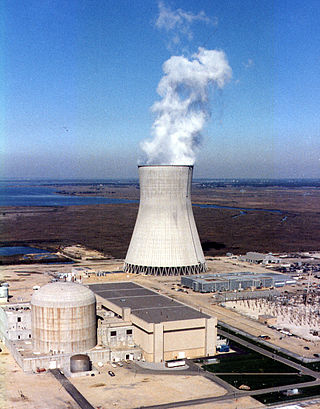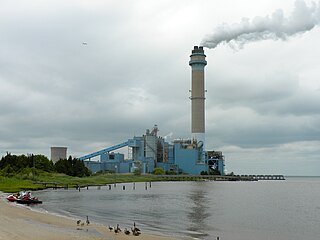The Public Service Enterprise Group (PSEG) is a publicly traded diversified energy company headquartered in Newark, New Jersey, US established in 1985 with a legacy dating back to 1903.

A fossil fuel power station is a thermal power station which burns a fossil fuel, such as coal or natural gas, to produce electricity. Fossil fuel power stations have machinery to convert the heat energy of combustion into mechanical energy, which then operates an electrical generator. The prime mover may be a steam turbine, a gas turbine or, in small plants, a reciprocating gas engine. All plants use the energy extracted from the expansion of a hot gas, either steam or combustion gases. Although different energy conversion methods exist, all thermal power station conversion methods have their efficiency limited by the Carnot efficiency and therefore produce waste heat.

Hope Creek Nuclear Generating Station is a thermal nuclear power plant located in Lower Alloways Creek Township, in Salem County, New Jersey, United States, on the same site on Artificial Island as the two-unit Salem Nuclear Power Plant. The plant is owned and operated by PSEG Nuclear LLC. It has one unit, a boiling water reactor (BWR) manufactured by GE. The complex was designed for two units, but the second unit was cancelled in 1981. It has a generating capacity of 1,268 MWe. The plant came online on July 25, 1986, licensed to operate until 2026. In 2009, PSEG applied for a 20-year license renewal, which it received in 2011 to operate until 2046. With its combined output of 3,572 megawatts, the Salem-Hope Creek complex is the largest nuclear generating facility in the Eastern United States and the second largest nationwide, after the Palo Verde Nuclear Generating Station in Arizona.

Longannet power station was a large coal-fired power station in Fife, and the last coal-fired power station in Scotland. It was capable of co-firing biomass, natural gas and sludge. The station stood on the north bank of the Firth of Forth, near Kincardine on Forth.

Homer City Generating Station is a decommissioned 2-GW coal-burning power station near Homer City, in Indiana County, Pennsylvania, USA. It is owned by hedge funds and private equity firms and is operated by NRG Energy. Units 1 and 2, rated at 660 MWe, began operation in 1969. Unit 3, rated at 692 MWe nameplate capacity, was launched in 1977. It employed about 124 people.
The Keystone Generating Station is a 1.71-gigawatt, coal power plant located on roughly 1,500 acres (610 ha) in Plumcreek Township, southeastern Armstrong County, Pennsylvania near Crooked Creek, just west of Shelocta, Pennsylvania.

The B.L. England Generating Station, also called Beesley's Point Generating Station, was a power plant in Upper Township, Cape May County, New Jersey, United States, on the Great Egg Harbor River. The facility provided approximately 450 megawatts of generating capacity from three generating units. Two units burned coal (and up to 7 percent Tire-derived fuel) and the third unit burned bunker C oil. Its large smokestack, altered to resemble a lighthouse, contained a sulfur dioxide scrubber which removed the SO2 from the flue gas and converted it into gypsum, which can be sold. The scrubber allowed the two coal units to use less expensive high sulfur coal from West Virginia.

The Conemaugh Generating Station is a 1,872 MW baseload coal-powered plant located on 1,750 acres (710 ha), across the Conemaugh River from New Florence in Western Pennsylvania. Track 3 of the Norfolk Southern Pittsburgh line runs next to the power plant.

Clifty Creek Power Plant is a 1,300-MW coal-fired power station located in Madison, Indiana. Clifty Creek is operated by the Indiana Kentucky Electric Corporation. It is named after Clifty Creek, which enters the Ohio River nearby.

Coal generated about 19.5% of the electricity at utility-scale facilities in the United States in 2022, down from 38.6% in 2014 and 51% in 2001. In 2021, coal supplied 9.5 quadrillion British thermal units (2,800 TWh) of primary energy to electric power plants, which made up 90% of coal's contribution to U.S. energy supply. Utilities buy more than 90% of the coal consumed in the United States. There were over 200 coal powered units across the United States in 2022. Coal plants have been closing since the 2010s due to cheaper and cleaner natural gas and renewables. But environmentalists say that political action is needed to close them faster, to reduce greenhouse gas emissions by the United States to better limit climate change.

The Dickerson Generating Station is an 853 MW electric generating plant owned by NRG Energy, located approximately two miles west of Dickerson, Maryland, on the eastern banks of the Potomac River.

The Chalk Point Generating Station is an electricity-generating plant, comprising oil and natural gas fired units, owned by NRG Energy, located near the town of Eagle Harbor, Maryland, United States, on the Patuxent River.

Brunner Island Steam Electric Station is a coal-fired, alternatively natural gas-powered electrical generation facility in York County, Pennsylvania. It occupies most of the area of the eponymous island on Susquehanna River. The power plant has three major units, which came online in 1961, 1965, and 1969, with respective generating capacities of 334 MW, 390 MW, and 759 MW. In addition, three internal combustion generators were installed in 1967. Talen Energy will stop coal use at the plant in 2028.

Danskammer Generating Station is located on the shore of the Hudson River in the Town of Newburgh, New York, United States, 0.5 miles (0.8 km) upstream of the larger oil-fired Roseton Generating Station. Danskammer 'units 1 and 2 burn natural gas as a primary fuel, and oil as a backup fuel, whereas units 3 and 4 are exclusively fired with natural gas.

The Boardman Coal Plant was a coal-fired power plant located in Boardman, Oregon. The facility had a nameplate capacity of 550 megawatts (MWs) and is owned by Portland General Electric. In 2010, the plant was the only remaining coal powered plant in Oregon and received much attention from regional media due to its being the largest single source of greenhouse gas emissions in the state with environmental groups such as the Sierra Club calling for its closing.

Brayton Point Power Station was a coal-fired power plant located in Somerset, Massachusetts. It was the largest coal-fired generating station in New England, and was the last coal-fired power station in Massachusetts to provide power to the regional grid. It had been owned by the power company Dominion Energy New England since 2005, after it was purchased from PG&E. The plant was owned from August 2013 to April 2015 by Energy Capital Partners, and is now owned by Dynegy. The plant ceased power generation and went offline on June 1, 2017.

Bergen Generating Station is a natural gas-fired power plant located in Ridgefield, New Jersey. The plant is owned and operated by Public Service Electric and Gas Company (PSE&G). It is adjacent to the Little Ferry railyard, within the New Jersey Meadowlands, on the banks of Overpeck Creek, near its confluence with the Hackensack River.

Kearny Generating Station is a peaking power plant on the banks of the Riverbend of the Hackensack River in South Kearny, New Jersey. Owned and operated by Public Service Electric and Gas Company (PSEG) the power station consists of 10 simple cycle combustion turbines totaling 456 MW. It is part of the PJM Interconnection of the Eastern Interconnection grid electric transmission system.

Conesville Power Plant was a 2-gigwatt, coal power plant located east of Conesville, Ohio in Coshocton County, Ohio. Its units were co-owned at the time of its closing by American Electric Power (AEP) and AES Ohio Generation. All plant operations were handled by AEP. Conesville began operations in 1957 and ceased generation in April 2020.


















